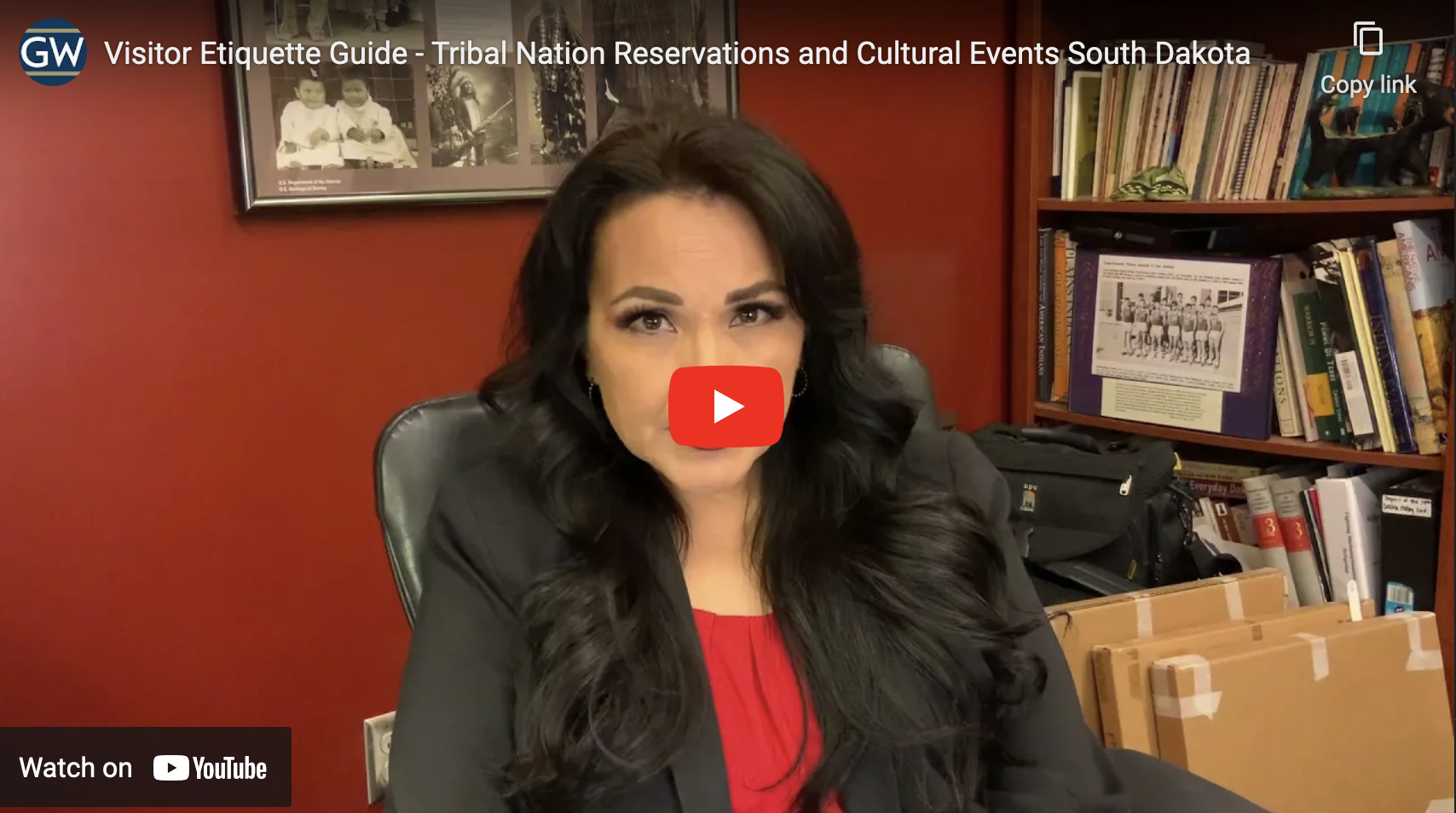Visitor Etiquette
VISITOR ETIQUETTE GUIDE
The nine federally recognized Tribal Nations in South Dakota are stewards of a diverse array of natural and cultural resources, with numerous authentic cultural heritage and outdoor recreation activities open to visitors. While visiting reservations or attending cultural events such as powwows (wacipi) it is important to respect local laws, customs, traditions and ways of life. This brief guide provides an overview of etiquette guidelines to help you make the most of these authentic experiences.This guide was created using resources provided by the nine Tribal Nations and other Native American visitor etiquette sources.
Thank you (Pilamaya, Pidamaya) for taking the time to learn more about our culture and ways of life. We look forward to sharing our history and culture with you, and ask for your respect (ohola, ohoda) and understanding.
GENERAL GUIDELINES
Obey all laws, including hunting and fishing regulations. Each Tribal Nation (oyate) is sovereign and protocols may vary. Before your trip, look on the official tribal website for any information on entry requirements. Check requirements and procedures for outdoor recreation permits in advance. Remember, you are a guest on sovereign land, so read signs and posted rules carefully and obey all tribal laws and regulations.
Stay on established roads and trails. Many roads and trails on tribal lands are not paved and may not be well marked. Avoid getting lost or accidentally causing damage by staying on established routes when walking, riding or driving, unless accompanied by a locally sanctioned guide. Do not rock climb, off-trail hike, go off-road or camp unless invited.
Do not bring or use alcoholic beverages or drugs. Although the use of these substances may take place on reservations, as a visitor and outsider it is advised that you do not indulge in these substances on reservations, out of respect.
Do not disturb any sites or areas that contain devotions or offerings. These sites are considered sacred and desecration will be taken very seriously. Ask permission before taking photos.
Do not disturb or remove artifacts, plants, or other objects.
Do not litter, and minimize your water and energy use whenever possible.
Drive slowly and obey speed limits. Our communities are slow-paced and it is not unusual to find and children near or on the roads. Help keep our roads safe.
Go with the flow. You may notice that the concept of time may be different when visiting the reservations or attending a cultural event. Timing for activities can be more fluid, and it is important to understand and respect this difference. We encourage you to relax and go with the flow. Everything will happen in the time it needs to.
Dress practically and respectfully. Comfortable, casual clothes such as jeans and shirts and practical shoes are the best choice, unless advised otherwise by your guide. Avoid revealing clothing; our communities tend toward modest dress. Native costumes, headdresses, feathers, or other regalia are never acceptable.
Treat residents with courtesy and respect. Respect the local preference for personal space: Do not touch someone you’ve just met unless they have initiated contact first. Do not force prolonged eye contact, as it is inappropriate in many Native communities. Avoid pointing with a finger, particularly the index finger, as it is considered impolite; you may notice individuals will point by pursing or puckering their lips and pointing with their eyes or nodding in the right direction.
Be polite and attentive when speaking to elders, veterans, and elected officials. Give elders the right of way and preferred seating. Serve elders first at meal times.
Be respectful of events and ceremonies. Ask whether visitors are welcome before attending an event or dance, as not all ceremonies are open to the public. Do not join a dance unless invited to do so; what appears to be a simple dance may be a religious ceremony. Ask before taking photos or videos.
Follow local food customs. Wait for a prayer or grace to be spoken before eating a meal. Refusing food that is offered to you would be considered rude; it is best to accept food or drink that is offered to you, even if you eat only a little. Respect local restrictions regarding the sales and consumption of alcohol on tribal lands. Serve elders their meal first, or wait for the elders present to be served first.
Support the local economy by buying locally made products and handcrafts. Do not haggle with artists unless community members tell you it is expected; Paying what is asked ensures artists are respected and receive a fair price for their work.
Ask local community members about the appropriateness of tipping, gift-giving or donating before doing so.
Always ask before taking photographs. Please ask your hosts about local rules and guidelines before taking photos. Do not use photographs for commercial purposes unless you have explicit permission from tribal officials.
VISITOR ETIQUETTE AT POWWOWS (WACIPI):
Powwows, or wacipi (the Dakota, Lakota and Nakota word for “dance”) are special cultural celebrations and social events. Powwows are a time for families, friends, and communities to meet, camp, visit and reconnect. Powwows are usually held in the summer and fall, and can last one day or several days. You can learn more about the history and significance of powwows by visiting tribal websites or from sources such as powwows.com. Note that the pandemic may have changed the schedule or availability of local powwows, and there may be special protocols for attending; check before you make plans.
Before getting into some more specific dos and don’ts, here are some important terms and protocols to keep in mind. Remember, these events are a special time to gather and connect, so if you are curious about what is going on, ask those around you!
GENERAL POWWOW PROTOCOLS
Grand Entry: The grand entry begins the powwow: All dance contestants enter the arena, led by the veterans, and an opening prayer is read. Stand, if able and remove your hat during the grand entry.
Regalia: Regalia, or traditional dress, is most often worn during ceremonies and celebrations. Regalia is often handmade and passed down as a family heirloom. Do not touch regalia without asking permission, as some regalia has deeply sacred or personal meaning or may be fragile. Know that some regalia has religious significance and should be worn only by those qualified to do so.
Dance arena: The dance arena or dance circle, often located within an arbor, is respected by powwow attendees. Do not cross or enter the dance arena after it has been blessed, except during open dances. Do not run or allow play within the arena.
Dropped feather: Eagle feathers are sacred to most Native Americans. When an eagle feather is dropped, veteran dancers must perform a special ceremony before the powwow continues. Do not pick up a dropped/fallen feather; leave it where it is and notify the nearest powwow staff member.
Seating: Since modern powwows often do not have enough bleacher seating for everyone, social norms have evolved to ensure most attendees can be comfortably accommodated. Take a lawn chair to the powwow if you can. Reserve a bleacher seat by placing a blanket over your spot. Do not take more space than you need. Do not reserve front-row seats; these are reserved for dancers, singers, and their families. Respecting elders is culturally very important, if you see an elder or someone with accessibility challenges who needs a seat, please offer yours and find a new location.
VISITOR ETIQUETTE AT POWWOWS
Powwow participants spend years honing their talents and powwows take months to organize. Attendees show their respect by adhering to mutually understood protocol. It is important to respect the event and avoid cultural and commercial exploitation of Tribal members and their traditions. Here are some general guidelines for attending a powwow or cultural event.
Personal interactions
- Be attentive to the Master of Ceremonies: Listen for instructions on when to stand, when and how to join in, and when photography is restricted.
- Feel free to ask the powwow staff/volunteers if you have any questions.
- Avoid engaging in public displays of affection as this may be considered impolite.
- Dress comfortably and casually unless advised otherwise. Avoid revealing clothing.
- Do not bring alcohol, drugs or weapons to the event; these are strictly prohibited at powwows.
Photography, recording, filming and sketching
- Ask before taking any photos.
- Follow instructions from the Master of Ceremonies on when videos or photographs are not allowed. Avoid photography during veterans’ songs, flag songs or prayers.
- Do not assume that if a dancer has given you permission to take a photo that you can use the photo in a publication. Obtain express approval from the subject of the photo before publishing any photo online or in print.
Gifts and donations
- Consider donating money toward the powwow if the opportunity arises. Most powwows are nonprofit events and donations help cover the costs.
- Take the time to visit the local vendors and artisans to support the local economy.
Participation
- Follow the lead of the community members in attendance. Everyone is welcome at public powwows, however there are times when attendees should not join the dancers and should stay out of the arena.
- If invited to join dancers in the arena during open dances; remember to wait for the Head Man, Head Woman Dancers and Head Staff to start dancing during an open dance before you join in. Move in a clockwise direction when in the arena.
We hope you will join us to experience and learn more about our history and culture, and encourage you to ask questions and engage. Safe travels, and we will see you soon.


